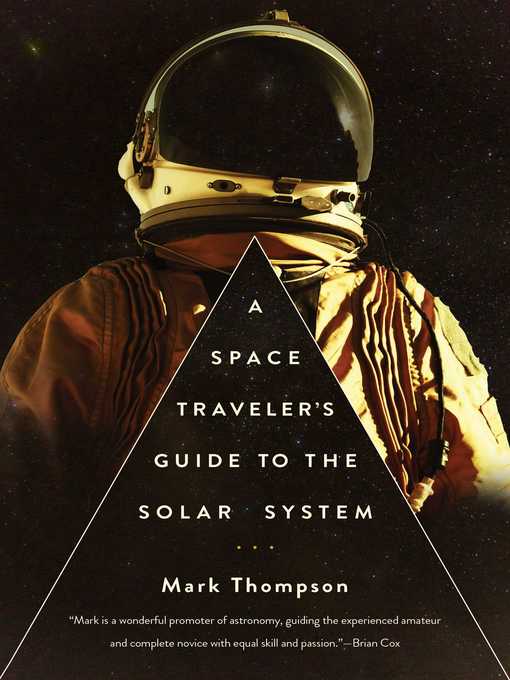-
Creators
-
Publisher
-
Release date
November 8, 2016 -
Formats
-
Kindle Book
-
OverDrive Read
- ISBN: 9781681772837
- File size: 1684 KB
-
EPUB ebook
- ISBN: 9781681772837
- File size: 1684 KB
-
-
Languages
- English
-
Reviews
-
Publisher's Weekly
September 12, 2016
“Departure from Earth is an emotional experience,” writes British astronomer Thompson as he leads a tour from the sun to the Oort Cloud, visiting each of the planets in turn. Beginning with a careful planning of routes, Thompson tackles the ins and outs of constructing a ship that will be protected from meteorites, solar flares, and cosmic rays. For each celestial object he visits, he presents a history of humans’ understanding of it along with what is known of its physical makeup. Thompson allows readers to imagine walking on planetary and lunar surfaces using his “Reality Suspension Unit,” though he discourages travelers from exploring the gas giants, which lack hard surfaces. Interesting factoids abound: Mars takes its red hue from the powdered rust coating its surface, and water tanks can be refilled on the Jovian moon Europa. Thompson also considers the psychological effects of years in space, the emotional need for fresh food, and how to have sex in zero gravity. Images of scenic wonders, including the ammonia volcanos of Titan with their close-up view of Saturn’s rings, make one long for a means of interplanetary travel. Thompson’s clear explanations and effusive delivery make this book a perfect companion for armchair voyagers. -
Kirkus
The popular host of the BBC's award-winning Stargazing Live takes readers on an imaginary journey throughout our solar system.Although many elements of such a trip are not yet possible, Thompson (A Down to Earth Guide to the Cosmos, 2013, etc.) makes it believable enough. First, as the author notes, traveling toward Mercury and Venus is relatively easy because the sun's gravitational pull would provide assistance. Journeying to the outer planets such as Neptune and Pluto is, of course, more difficult. Fortunately, an advanced propulsion system, the newly developed "Variable Specific Impulse Magnetoplasma Rocket," could do the job. Thompson explores the latest thinking about the origins of the moon and planets--e.g., the idea that our moon was created out of debris when "a large object about the size of Mars [may have] struck earth around 4.5 billion years ago." A serious problem that voyagers would face is shielding themselves from cosmic radiation, which has been experienced by astronauts who report "seeing flashes of white," a phenomenon currently attributed to "cosmic rays passing through their heads." Growing food, disposing of waste, exercise, recreation, and even intimate relations would need to be factored in to planning such a lengthy trip. Another necessity would be replicating gravity. A tempting stopover might be Jupiter's moon, Titan, which appears to be "similar to Earth when it was in a more primitive state." Thompson claims that it could support "primitive alien life, and he discusses the 1972 " 'flotilla' of unmanned space ships that...already visited the outer Solar System" and relayed information back to Earth. It is this data that informs Thompson's speculations, many of which are intriguing. Unfortunately, the author is writing about a well-mined subject. Despite his mostly appealing prose and useful details, the book, which could have been more fully fleshed out, suffers in comparison to Julian Guthrie's recent How to Make a Spaceship (2016). Thompson is a knowledgeable and capable guide, but his many fans may prefer to stick to his TV shows. COPYRIGHT(1) Kirkus Reviews, ALL RIGHTS RESERVED.
-
Library Journal
Starred review from November 15, 2016
Astronomer Thompson takes us on an imagined spaceship trip around our cosmic neighborhood, describing how such a voyage could be planned using only the technology that exists today. As readers visit the sun, its planets and their satellites, and the assorted other objects that orbit it, they learn what it would be like if humans could descend to the surface of each in turn. Whereas a few decades ago, knowledge of these areas was discerned using earthbound telescopes, today, observations by the Hubble telescope, space probe flybys, and the number-crunching capabilities of modern computers used to analyze mountains of data have vastly expanded our understanding. In particular, the book discusses the new theories of planetary formation and the discovery of systems around other stars. It offers suggestions of places where life has evolved and describes locations that could be colonized by humans in the future. Thompson further points out certain mysterious structures yet to be identified and offers possible explanations. VERDICT This excellent title should find a large readership among laypeople interested in astronomy and planetary science.--Harold D. Shane, Mathematics Emeritus, Baruch Coll. Lib., CUNY
Copyright 2016 Library Journal, LLC Used with permission.
-
Loading
Why is availability limited?
×Availability can change throughout the month based on the library's budget. You can still place a hold on the title, and your hold will be automatically filled as soon as the title is available again.
The Kindle Book format for this title is not supported on:
×Read-along ebook
×The OverDrive Read format of this ebook has professional narration that plays while you read in your browser. Learn more here.



